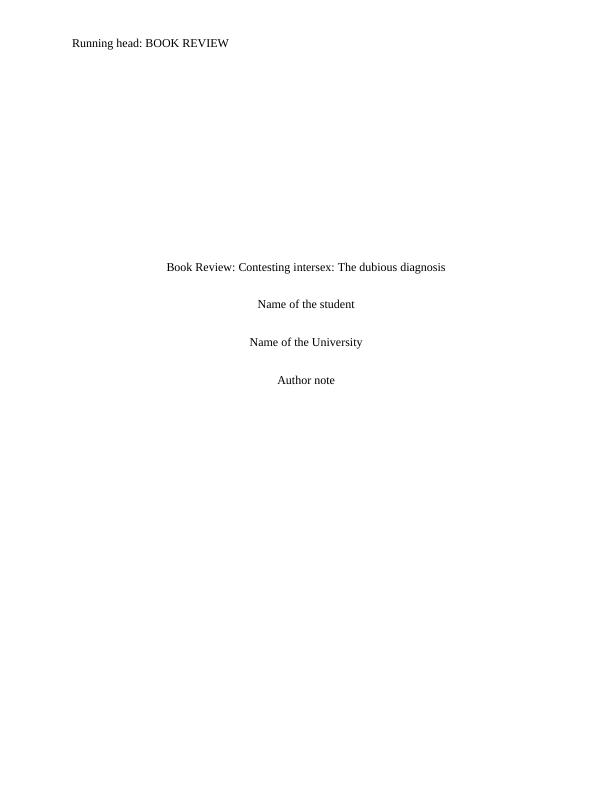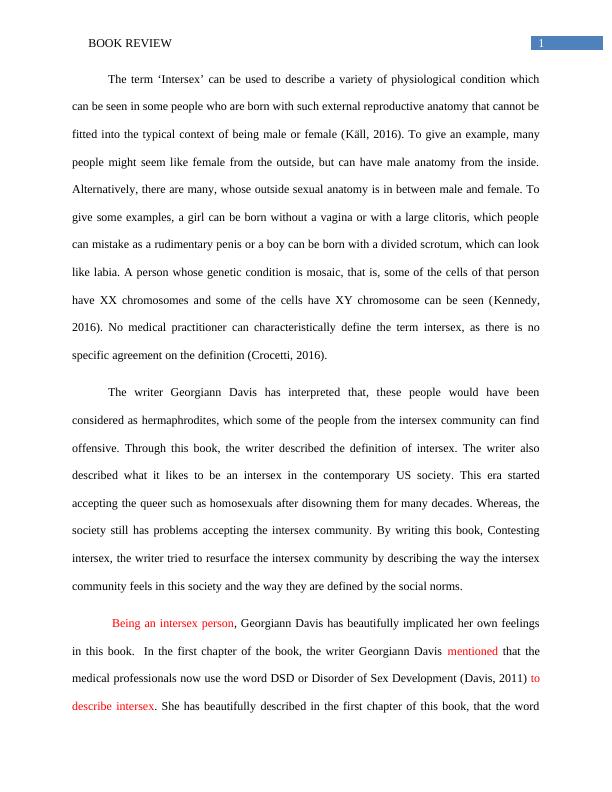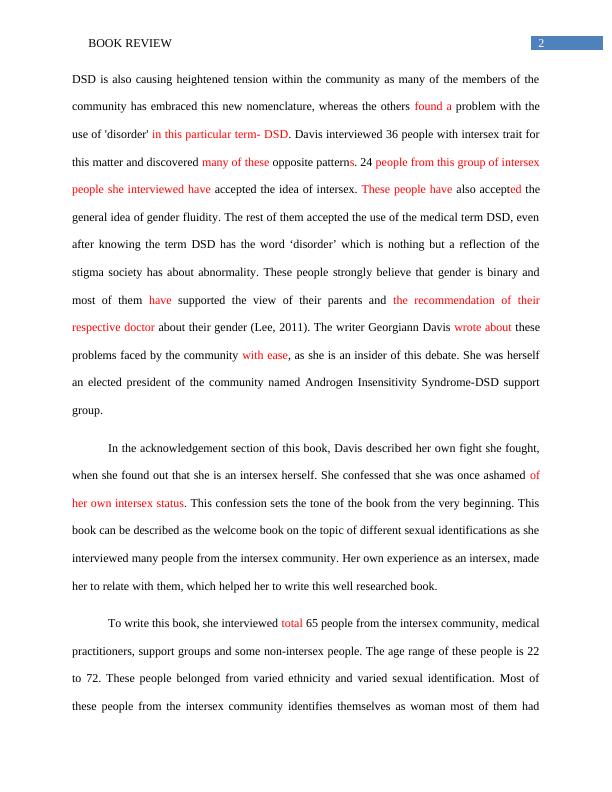Ask a question from expert
Book Review: Contesting intersex: The dubious diagnosis Name of the student Name of the University Author note
12 Pages3626 Words327 Views
Added on 2020-04-21
About This Document
BOOK REVIEW 6 BOOK REVIEW Book Review: Contesting intersex: The dubious diagnosis Name of the student Name of the University Author note The term ‘Intersex’ can be used to describe a variety of physiological condition which can be seen in some people who are born with such external reproductive anatomy that cannot be fitted into the typical context of being male or female (Kll, 2016). In the first chapter of the book, the writer Georgiann Davis mentioned that the medical professionals now use
Book Review: Contesting intersex: The dubious diagnosis Name of the student Name of the University Author note
Added on 2020-04-21
BookmarkShareRelated Documents
Running head: BOOK REVIEWBook Review: Contesting intersex: The dubious diagnosisName of the studentName of the UniversityAuthor note

1BOOK REVIEWThe term ‘Intersex’ can be used to describe a variety of physiological condition whichcan be seen in some people who are born with such external reproductive anatomy that cannot befitted into the typical context of being male or female (Käll, 2016). To give an example, manypeople might seem like female from the outside, but can have male anatomy from the inside.Alternatively, there are many, whose outside sexual anatomy is in between male and female. Togive some examples, a girl can be born without a vagina or with a large clitoris, which peoplecan mistake as a rudimentary penis or a boy can be born with a divided scrotum, which can looklike labia. A person whose genetic condition is mosaic, that is, some of the cells of that personhave XX chromosomes and some of the cells have XY chromosome can be seen (Kennedy,2016). No medical practitioner can characteristically define the term intersex, as there is nospecific agreement on the definition (Crocetti, 2016). The writer Georgiann Davis has interpreted that, these people would have beenconsidered as hermaphrodites, which some of the people from the intersex community can findoffensive. Through this book, the writer described the definition of intersex. The writer alsodescribed what it likes to be an intersex in the contemporary US society. This era startedaccepting the queer such as homosexuals after disowning them for many decades. Whereas, thesociety still has problems accepting the intersex community. By writing this book, Contestingintersex, the writer tried to resurface the intersex community by describing the way the intersexcommunity feels in this society and the way they are defined by the social norms.Being an intersex person, Georgiann Davis has beautifully implicated her own feelingsin this book. In the first chapter of the book, the writer Georgiann Davis mentioned that themedical professionals now use the word DSD or Disorder of Sex Development (Davis, 2011) todescribe intersex. She has beautifully described in the first chapter of this book, that the word

2BOOK REVIEWDSD is also causing heightened tension within the community as many of the members of thecommunity has embraced this new nomenclature, whereas the others found a problem with theuse of 'disorder' in this particular term- DSD. Davis interviewed 36 people with intersex trait forthis matter and discovered many of these opposite patterns. 24 people from this group of intersexpeople she interviewed have accepted the idea of intersex. These people have also accepted thegeneral idea of gender fluidity. The rest of them accepted the use of the medical term DSD, evenafter knowing the term DSD has the word ‘disorder’ which is nothing but a reflection of thestigma society has about abnormality. These people strongly believe that gender is binary andmost of them have supported the view of their parents and the recommendation of theirrespective doctor about their gender (Lee, 2011). The writer Georgiann Davis wrote about theseproblems faced by the community with ease, as she is an insider of this debate. She was herselfan elected president of the community named Androgen Insensitivity Syndrome-DSD supportgroup. In the acknowledgement section of this book, Davis described her own fight she fought,when she found out that she is an intersex herself. She confessed that she was once ashamed ofher own intersex status. This confession sets the tone of the book from the very beginning. Thisbook can be described as the welcome book on the topic of different sexual identifications as sheinterviewed many people from the intersex community. Her own experience as an intersex, madeher to relate with them, which helped her to write this well researched book. To write this book, she interviewed total 65 people from the intersex community, medicalpractitioners, support groups and some non-intersex people. The age range of these people is 22to 72. These people belonged from varied ethnicity and varied sexual identification. Most ofthese people from the intersex community identifies themselves as woman most of them had

3BOOK REVIEWformal education. She had attended many of the meetings of intersex organizations to observepeople. She has spent almost 300 hours just to observe the social interaction of the intersexpeople. This book has six chapters. The introductory chapter is named interestingly ‘You’re inthe Monkey Cage with me’. In this chapter, she described her own journey as an intersex person.The writer herself has diagnosed with CAIS (Complete Androgen Insensitivity Syndrome). Fromthis chapter we get to know the starting of her own journey as an intersex person. The writer wasdiagnosed with CAIS when she was just 13. Her parents and the doctors lied to her about hercondition as they removed the rudimentary testes from her body when she was just seventeen.She was told by her parents that she had underdeveloped ovaries, which were being removed asit could cause cancer. It was at 19; she had encountered with her medical records and learntabout her condition. The writer admitted that she was ashamed when she first learnt that she hadXY chromosome (Male chromosome). She accepted her condition when she was almost 30 yearsold. This well written introductory chapter made us to be the silent witness of her journey as weread her journey through her eyes. In the reminder of the introductory chapter, she wrote herstudy of this community through theoretical and methodological perspective. To write the study,she interviewed the people from her community and lastly she turned the methodological lens byherself. For herself, she used the concept of ‘looking glass’ self (Cornwall, 2014). This book isbased on her dissertation and examined the term intersex on institutional and individual level.From all the chapters of this book, I found the chapter four, the most interesting. Thenaming of this chapter is also interesting as it called ‘The Power in a Name”. Naming seems asimple process. It is very difficult for the people from the intersex community to be labeled as aboy or girl as they struggle with their gender identity. In the recent times, the first world

End of preview
Want to access all the pages? Upload your documents or become a member.